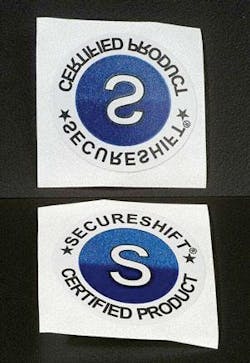OPTICALLY VARIABLE PIGMENTS: Pigeon-feather facades foil brand and currency forgery
Inspired by the colors produced by nature on abalone shells, butterflies, mallard ducks, hummingbirds, peacocks, and pigeons, engineers in the Flex Products Group (Santa Rosa, CA) of JDS Uniphase (JDSU; San Jose, CA) are developing a dazzling array of interference-based pigment techniques for a range of applications that includes combating counterfeiting and painting cars.
Unlike chemical-based colors, which rely on the selective absorption of specific wavelengths of light by organic compounds (chromophores), interference-based colors depend on constructive and destructive interference in thin films such as those found in abalone shells and soap bubbles or on the dispersion of light into discrete wavelengths by diffraction gratings such as the feathers of mallard ducks, hummingbirds, peacocks, and pigeons. Because absorption-based color is an intrinsic quality of the material being viewed, it does not change with viewing angle; in contrast, interference-based color changes with viewing angle and can appear even in transparent and colorless materials.
This effect can be important for nations or corporations concerned with counterfeiting because interference-based color schemes incorporated into currencies or brand labeling cannot be reproduced through scanning or photocopying. In addition, unlike the engraved holograms on credit cards that shift appearance with viewer perspective, interference-based color shifts cannot be copied by simply taking a wax mold. Even for purely commercial purposes such as painting cars or adorning consumer items, interference-based coloration methods allow designers to work with a palette that is literally dynamic and sparkling.
Difficult to counterfeit
Because color-shifting effects are obvious to the unaided eye they are desirable for decorative and security applications. The benefit in security applications is twofold: the obvious color shift helps to detect and deter counterfeiting. That the color-shifting effects can only be reproduced through a highly sophisticated combination of technical and manufacturing wizardry offers an additional advantage for security, even though it can make the process a bit pricey for coloring commodity items.
The thin-film pigment is based on identical back-to-back Fabry-Perot cavities applied to a surface in a single layer of 1-µm-thick flakes. A transparent glass layer sandwiched between an opaque reflective metal and a semitransparent absorber material forms each Fabry-Perot cavity. As the angle of viewing increases away from the normal, the optical-path length through the Fabry-Perot cavity changes, causing the viewer to perceive a change in color.
When the pigment is applied to a surface, there is no way to know beforehand whether individual flakes will land right side up or upside down. So the 1-µm flake thickness actually consists of back-to-back Fabry-Perot cavities in a symmetric five-layer structure. The opaque metal reflector is in the center with identical transparent and semitransparent layers on either side. Manufacturing tolerances must be controlled to a thickness of within a couple of atoms to provide color uniformity on both sides over very broad surfaces-one of the factors that makes interference-based methods difficult to counterfeit.
Diffraction, thin-film, holographic, and organic color methods can also be combined, together and with other security techniques, to yield highly interesting visual effects as well as highly complex security patterns. For instance, interference thin films shift in color from long to short wavelengths with increasing viewing angle, while diffraction gratings shift in color from short to long wavelengths. Diffraction gratings can also change and can also be rotated to yield different imagery. Perhaps because the resulting multidimensional color mazes convey color depth similar to the manner in which holograms convey spatial depth, engineers at JDSU refer to them as chromograms (see Fig. 1).2
In combination with other holographic and coloring effects, the thin-film techniques are already deployed on a variety of JDSU decorative and security products, while diffractive technologies are just completing development and beginning to enter the product mix. For security applications alone, the technology is currently in use on more than 100 monetary currencies worldwide, as well as in brand-protection applications for wine and spirits, luxury goods, licensed products, and pharmaceuticals (see Fig. 2). Counterfeiting of branded products, including software, pharmaceuticals, auto and aircraft spare parts, and other consumer products, has been estimated to account for more than 5% of world trade and as much as $500 billion in lost revenues annually.
REFERENCES
1. B. Parker, Paint & Coatings Industry (September 2004).
2. R. W. Phillips, A. Argoitia, 48th Annual Technical Conf. Proc., Society of Vacuum Coaters (2005).
About the Author
Hassaun A. Jones-Bey
Senior Editor and Freelance Writer
Hassaun A. Jones-Bey was a senior editor and then freelance writer for Laser Focus World.

